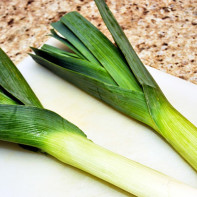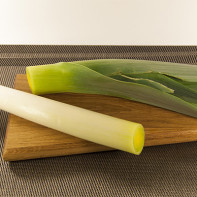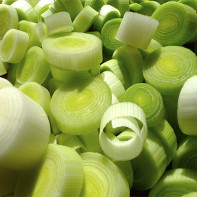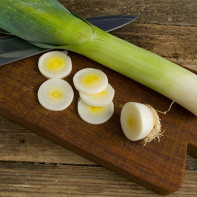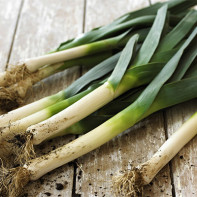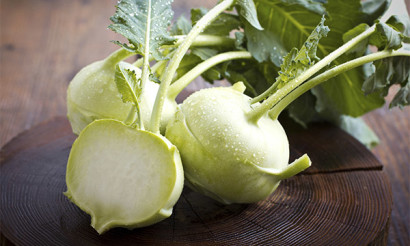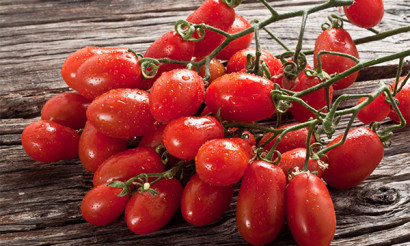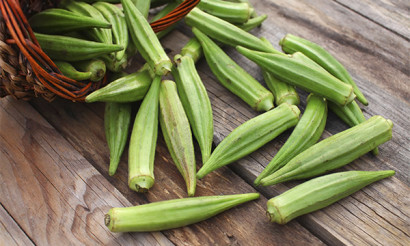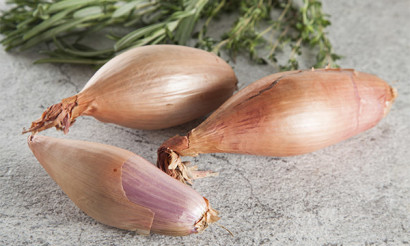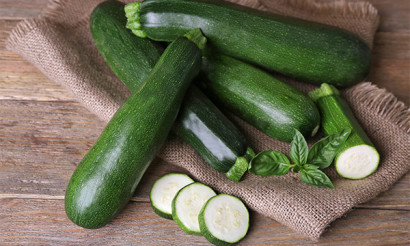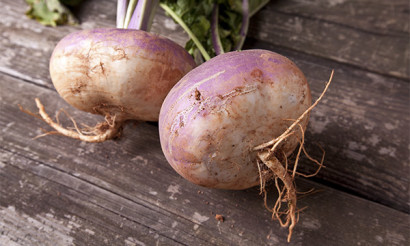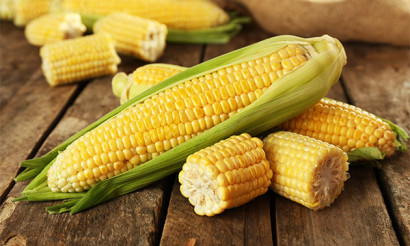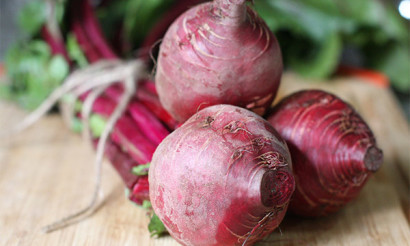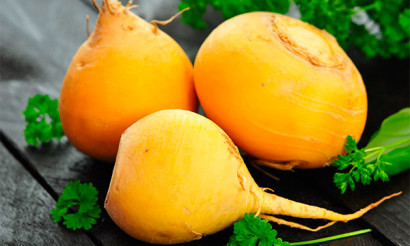Leek: benefits and harm to the body
Leek is a common variety of edible biennial herb that is widely used in many world cuisines. Unlike the green onion, identical in appearance to it, leek does not have a bulb. It is distinguished by a thick trunk and relatively large leaves of saturated green color.
- What leek looks like
- How leek differs from ordinary onions
- What is the difference from a bow-onion
- Composition and calorie content
- Why leek is good
- General benefit
- For women
- For men
- During pregnancy
- When breastfeeding
- For kids
- When losing weight
- Leek in medicine
- With diabetes
- With pancreatitis
- With gastritis
- With gout
- Traditional medicine based on leek
- Application in cosmetology
- Harm and contraindications
- How to choose and store leeks
- Is it possible to freeze
- How to eat leek
- Is it possible to eat the green part
- What can be cooked from leek: recipes
- Creamy Salmon Soup
- Salad with Leek and Mayonnaise
- Leek Salad with Olives
- How to bake leek
- How can I replace leeks
- Interesting Leek Facts
Depending on the variety, the leek length varies: from very small to 30–40 cm. The taste of leek is unique - it simultaneously combines piquant spice and pronounced sweetness. Therefore, in dishes it is often used as one of the main ingredients. But its use is not limited to cooking, due to its rich vitamin composition it is also found in recipes of traditional medicine. How leek differs from other varieties of onions, what is its benefit to the body, and in which case it is better to refuse from its use - we read further in the article.
What leek looks like
Leek is a derivative of grape onions, which can still be found in Italy, Greece and some eastern countries. It belongs to the herbaceous biennials of the onion subfamily of the Amaryllis family. Its second name is pearl.
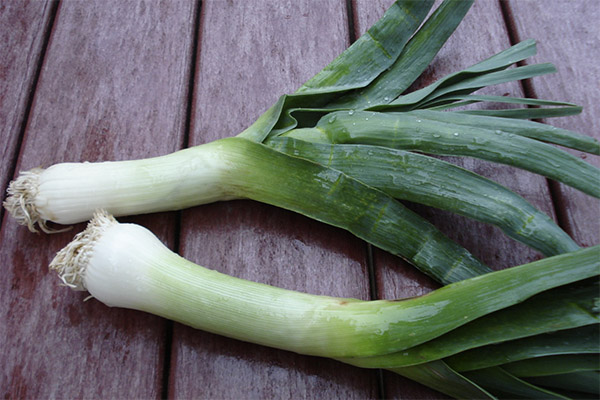
The leek bulb is either completely absent or poorly expressed. A large stalk of white color comes out from its center, also called a stem. Thin green leaves of the lanceolate type grow from its top.
Leek begins to bloom in mid-summer. It has a fairly large umbrella inflorescence resembling a ball. In the first year of life, the root system is laid in the plant, in the second - the stem and leaves.
How leek differs from ordinary onions
Leek differs from a classic onion in a different structure. It has no bulbs, and it consists of an elongated trunk and feather leaves. In the same way, it differs from ordinary green onions. As for the taste, then the differences are not so obvious. Ripe leek has a more delicate, sweet taste. He does not have the bitterness of onions. It is due to this unique property that leek is present in many dishes of French cuisine. There they add it even to pancake dough.
Leek is 3 times more productive than onions, it is relatively unpretentious to storage conditions, does not lose its properties within 6 months after harvest.
What is the difference from the onion-batun
Onion-batun is very similar to green but its arrows are larger in size and rougher in taste. It does not have a false white stem (another name is “leg”), unlike leek.
Composition and calorie content
In 100 g of leeks, only 33 kcal. Proteins account for up to 2.0 g, carbohydrates - up to 8.2 g, fats - 0 g. Almost 90% of its composition is water, but dietary fiber, starch, sugar and organic acids are also present. As for minerals, it contains manganese, potassium, phosphorus, magnesium, calcium and iron. Leek contains vitamins of group B (B1, B2), vitamin E, C, carotene.
Why leek is good
General benefit
In addition to the fact that this type of onion is distinguished by excellent taste, it also has great health benefits:
- Due to the presence of sulfur in the leek, the inflammatory reaction in the body is suspended.This substance is also considered a first-class prophylactic against arthritis, it does not allow the deformation of cartilage.
- In leek, there is quercetin - this is one of the recognized antioxidants that neutralizes the negative effects of free radicals, it protects against cancer, neutralizes allergens and their external manifestations on the skin, and suppresses asthma attacks.
- Leek is effective for digestive disorders, constipation, as an antibacterial, expectorant and antifungal agent.
- Due to the high concentration of potassium, it has a good diuretic effect.
- The product also promotes tissue regeneration, lowers blood cholesterol, and acts as an effective anti-diarrhea drug.
- Onion contains a unique mustard oil - allicin, which has a disinfecting property; it works especially well with infections of the genitourinary system.
- The product helps improve vision and improve overall eye health.
- Leek is indicated for people suffering from anemia because it raises iron levels.
For women
Women should definitely pay attention to leeks if they want to stay young and beautiful for a long time. A high concentration of ascorbic acid helps to strengthen the immune system, normalizes the emotional background and relieves nervous tension. It does not allow the early appearance of wrinkles, improves the condition of the hair.
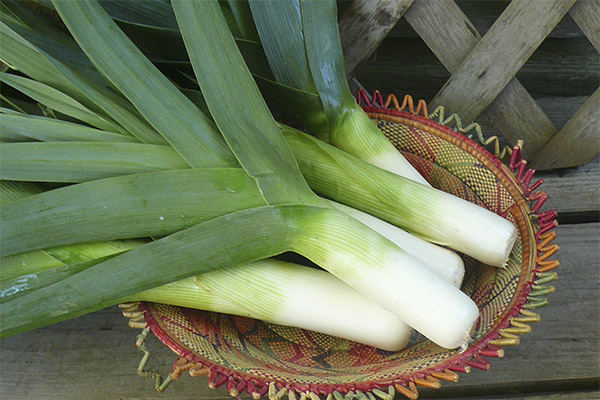
Quercetin present in leek is considered one of the best antioxidants. Its ability to stop the growth of cancerous tumors has been proven. Kempferol - another antioxidant - is especially useful for women, as it is an effective prophylactic against ovarian cancer.
For men
A few centuries ago, leek was one of the most common natural aphrodisiacs. Therefore, men suffering from low libido should add it to their diet. It is advisable to use it daily, while the minimum permissible frequency is several times a week.
For representatives of a strong half of humanity, leek is also recommended as a natural source of vitamins. It fills with energy, which can be fundamentally important for athletes with increased power loads.
During pregnancy
If there is no individual intolerance to the product, leek can be eaten by women in position, but in a limited amount (no more than 150 g per day) and not daily. Ideally, 2-3 times a week. Due to the large amount of vitamin C, it will protect the future mother's body from colds and viral infections. The folic acid present in leek (32 mg per 100 g) protects the fetus from malformations and is responsible for the formation of a healthy nervous system. Dietary fiber provides daily stool.
When breastfeeding
Leek, like regular onions, can be returned to the diet when breastfeeding no earlier than 3 months from the date of birth. This is due to the fact that its specific taste can affect the taste of milk, and the baby will refuse to breast.
For kids
In the children's menu, leek should also be. Children under one year of age can be given in boiled form, grated to a state of mashed potatoes. It is necessary to start complementary foods with 1/3 teaspoon, gradually bringing to 1 teaspoon in one serving. The best time for its first entry is 8 months. It goes well with other vegetables suitable for complementary foods. Leek is beneficial for children as an excellent source of vitamin C and iron. It helps to strengthen the immune system and prevents iron deficiency anemia. Magnesium and folic acid are responsible for the normal functioning of the nervous system.
When losing weight
The leek contains no fat at all, so it can be eaten during the diet without fear of the opposite effect. Due to the lack of fats, it poorly satisfies hunger, but in combination with other vegetables in salads contributes to a gradual saturation. Leek stabilizes metabolic processes in the body, helps to naturally remove toxins and poisons.
Leek in medicine
Leek is also highly regarded in medical practice. Doctors recommend it for digestive disorders, rheumatism and diseases of the nasopharynx. It helps to cleanse the blood, with regular use it normalizes metabolic processes, therefore it can be useful to people with chronic diseases of any localization.
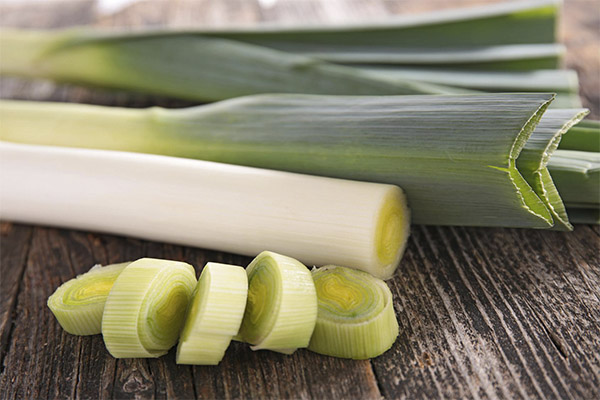
With diabetes
This disease is characterized by high blood sugar and insufficient insulin for its utilization. One of the amazing properties of leeks is that it is able to lower the level of glucose (due to its allicin content). Therefore, people suffering from diabetes should add this kind of onion to their diet. To enhance the effect, leek should be used with other plants that differ in their ability to lower glucose levels - plantain, dandelion.
Important: the glycemic index of leeks is 30 units.
With pancreatitis
The leek contains essential oils that provide its unique aroma and taste. Therefore, when it is consumed, a sharp release of gastric juice occurs, which can adversely affect the state of the pancreas, especially if it is inflamed. In this condition, the use of leeks must be completely abandoned. When the exacerbation phase is overcome, it can gradually begin to be returned to the diet, but only in a heat-treated form (boiled, baked or stewed). Fresh it is better not to use it, because it can provoke a second attack.
With gastritis
In the acute phase of gastritis, leek should be discarded. As in the case of pancreatitis, it will irritate the sensitive gastric mucosa and only increase its inflammation due to increased production of gastric juice. The main reason is essential oils. During the transition in a state of remission, its use is permissible, but again only in stewed or boiled form.
With gout
Leek is one of the few foods that can be eaten with gout without any serious restrictions. There are practically no purines in it that could aggravate the course of the disease. In the absence of any chronic pathologies from the gastrointestinal tract, it can be eaten both raw and baked or boiled. In the case of young leek, it is better to give preference to a simple fresh salad with vegetables.
Traditional medicine based on leek
Leek is a widespread ingredient found in many recipes of folk healers.
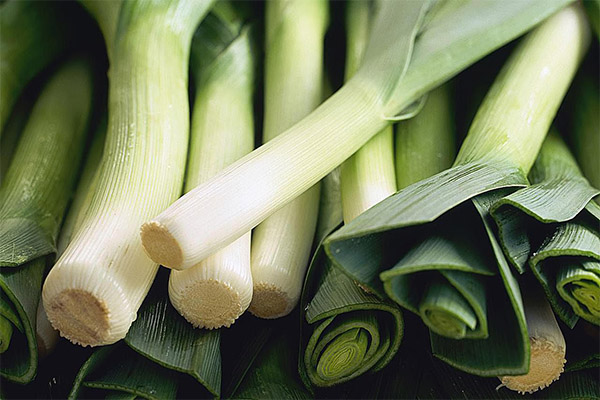
- In its pure form, it is used to relieve redness and pain during sunburn. To do this, grind it into gruel, squeeze the juice, apply to the affected area of the body and hold for about 50 minutes, then rinse with water. Grated leek can also be applied to corn, but it must be kept for at least an hour and a half.
- With pneumonia, the natural aroma of onions will help speed up recovery. To do this, you need to properly prepare it: finely chop and put into some container for convenient inhalation. For each subsequent procedure, it is advisable to prepare a fresh fresh portion of onion.
- The people have a proven recipe for treating sore throat based on leek. All you need to do is grind it and squeeze it well. The resulting juice should be drunk 1 tsp. 3-4 times a day and gargle with them. Leek juice also copes with a runny nose - you need to instill 2 drops into each nostril 2-3 times a day, and within 3 days the cold will recede. With otitis media, cotton turunds need to be moistened with leek juice and laid alternately in each nostril.
- Men who have a problem with potency should eat fresh gruel from the leek. The optimal dosage and duration of the course - 2 tbsp. 3 times a day, regardless of the meal for 3 months.If there is no way to maintain such a diet, you can simply add leek to traditional daily vegetables. It can be lightly steamed in a pan as a complement to meat.
- A small amount of grated leek (30 to 50 g) should be mixed with 1 tbsp. flour and the resulting mixture put in place of a boil or bruise. This compress is characterized by a warming and at the same time bactericidal effect.
- To increase immunity, 150 g of fresh leek should be chopped and combined with 30 g of cold-pressed olive oil. Take 1 tbsp. 3 times a day. The same amount of onion can be combined with 40 g of honey and take 15 g (one tablespoon) during each meal. It will also help strengthen the body's natural protective functions and make up for the deficiency of vitamins and minerals in the autumn-winter period.
Application in cosmetology
Beauticians also rated leek as a skin care product. Therefore, based on it, make face masks, the effect of which is identical to peeling.
To prepare the mask, the leg of leek with a small amount of the green part must be ground in a blender or meat grinder until gruel. After it is squeezed out well, to remove the allocated juice. Add 1 tablespoon to the onion lemon juice, 5 drops of cosmetic almond oil, mix and apply on the face with a thin layer. The mask must be held for 20–25 minutes, then carefully removed with a damp cotton pad or washed with warm water.
A mask based on gruel from leeks can also be rubbed into the hair roots to strengthen them. In this composition, you can add 1-2 tbsp. burdock oil. This composition will stimulate growth and help get rid of dandruff. For greater effect, add 1 tsp. dry mustard diluted in warm water.
Those who are faced with the problem of brittle nails can be recommended to apply gruel from leek directly to the nail. After that, each finger must be wrapped with cling film and left for 15 minutes. With the systematic use of such a mask, you can solve the problem even without the use of additional pharmacy products.
Harm and contraindications
The relative disadvantage of this type of onion can be considered its ability to enhance sweating due to the essential oils. This can complicate everyday life.
The plant should not be eaten by people suffering from low blood sugar, as it can lower it even more, as well as in case of nickel allergy.
How to choose and store leeks
Leeks can be sold in different forms:
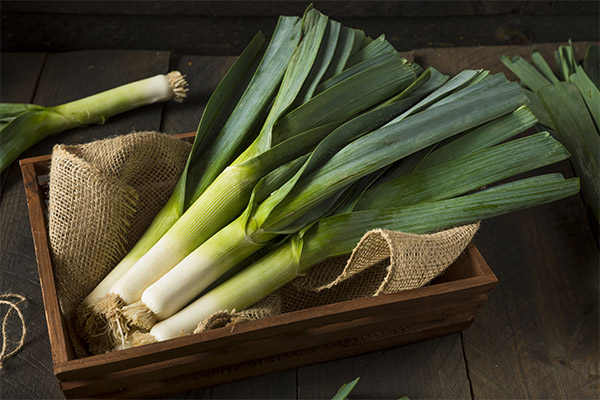
- by the piece;
- in vacuum packaging;
- bunches;
- in plastic containers.
If the shape of the package or its absence allows you to smell the bulb, this must be done. The fragrance says a lot about the freshness of the product. Leek should be bought based on the following rules:
- Good leek has white legs and green leaves, on which there are no signs of disease or wilting. Closer to the stem, they can have a lighter shade, even white. This is normal, but they should not have any spots, small dots or sharp color changes.
- The stem should be white - the lighter it is, the tastier. At the same time, its length should not be more than 6 cm. This is a certain criterion by which the quality of this variety of onion is determined.
- The optimal diameter of the leg is 1.5 cm. If it is larger, then this indicates that the onion is old.
- The product should not have unnatural gloss.
- If traces of a slice are visible on the leaves, it means that it has already begun to dry out, and in the store they tried to give it a presentation.
- The stem must be in the shape of a cylinder; it cannot have any head.
- Any yellowness on a leg or leaves indicates that the onion begins to rot.
If the leek is sealed in a package, then you need to inspect it for integrity. In this case, the onion must meet the above criteria. It should not be too soft or too hard.
Note! Leek is on sale almost year-round, but it is better to buy it from the end of autumn until March - this is the time of its natural maturation.
Leek can be stored exactly like green leek. It is best left in the refrigerator in the appropriate compartment for storing vegetables. Outwardly, the leaves seem strong, but it is easy to deform them, and after damage, they begin to quickly dry out and deteriorate.
Leek storage recommendations:
- The lower part of the leg needs to be cut off by about 2 cm, the leaves should be examined for dried or yellow.
- If there is too much onion, then it’s more reasonable to put the leek in the cellar, which will be cool in any weather.
- Before you put the onions in the refrigerator, you do not need to wash it - water will shorten its shelf life.
- Any form of preparation is suitable - pickling, pickling or canning.
- To extend the initial state of leek, it can be tightly wrapped in kraft paper.
- It is not advisable to store it in a bag, but if for some reason it does not work out differently, then you need to make small incisions to drain the condensate.
- If the onion gets an unpleasant odor during storage, it should not be eaten, because it will affect the taste badly.
- Leek should not be frozen. It can either be kept fresh or fully frozen.
At room temperature, the leek will remain fresh for 14 days, but should not be exposed to direct sunlight. High humidity also negatively affects its taste.
Is it possible to freeze
This storage principle is valid. But before freezing it needs to be washed well, because most of the dirt and sand is clogged precisely between the leaves. Be sure to cut off 2 cm of the legs and review the leaves (dried up - remove). Then it needs to be dried very well. For freezing, it is desirable to cut it into small circles with a diameter of up to 2-3 mm. If the stem is too large, it can be cut in half and cut into halves.
Next, you need to freeze it a little. This is done so that in the future the onion is easily poured from the container in which it will be stored, even if it is a regular bag. To do this, pour it onto a flat dish (a cutting board is also suitable) and cover with cling film. It prevents the spread of aroma in the freezer. In this condition, it must be left in the freezer for several hours, provided that the temperature in it is at least -15 degrees. When the leek is a little frozen, it needs to be transferred to a container for freezing. It can be a bag or a food container.
How to eat leek
Many people, having once tried leek, refused to eat it, arguing that its green part is too hard and does not soften even after cooking. But the main mistake of this statement is that only the stem and the maximum light green part of the leaves are consumed. They have a unique taste, not like ordinary onions.
Is it possible to eat the green part
The green part is really very tough and should not be eaten. It is almost impossible to make it softer, but throwing it away is also impractical. Many experienced cooks make on its basis a so-called garni bouquet - this is a bunch of dried herbs (basil, parsley, rosemary, tarragon and other components), tied with a thread. It is used in the preparation of various soups. The bouquet is lowered into the pan after boiling water and removed a few minutes before cooking. It adds an amazing flavor to the dish, making it richer and brighter.
Another great way to use the green part is as a backing when cooking steamed dishes.
What can be cooked from leek: recipes
The most famous leek recipes are salads, soups and numerous open pies. It can serve as an excellent side dish if you simply stew it with a small amount of lemon juice. It is combined with tomatoes, so it is often used on bruschettas. With long cooking, leek is boiled, which can be useful if you need to thicken stewed vegetables.
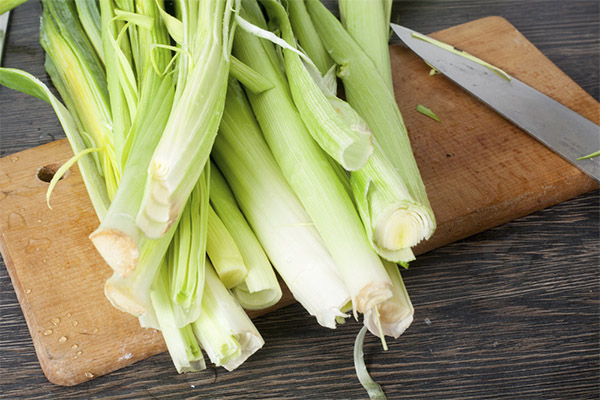
Creamy Salmon Soup
This is one of the best recipes for leeks. But technically it can be used in the preparation of any traditional soups in which leek is provided.
To prepare a creamy soup with salmon, the following components are needed:
- 1.5 kg of fresh salmon;
- 200 g of smoked pink salmon;
- 1 carrot;
- 3-4 potatoes;
- 1 small celery root;
- 1 large stalk of leek;
- 1 head of fennel;
- 1 small bunch of dill;
- 400 ml of cream with a fat content of at least 20%;
- 1 tbsp flour;
- salt and white pepper to taste.
The sequence of actions should be as follows:
- We gutted the fish, cut off the tail, fins and head (we must take the gills out of it), put them in a saucepan and pour 2 liters of clean water. We put on medium heat, bring to a boil. After we remove the formed foam and continue to cook for half an hour.
- We cut the rest of the carcass into fillets, remove the bones and divide into small portions. We do the same with pink salmon.
- We wash and peel the vegetables. Cut the carrots and celery into small strips, and the potatoes into medium-sized cubes. Leek shred rings, and fennel first cut in half, after each half into 3-4 parts.
- First add carrots and celery to the barely boiling broth, after 7-10 minutes - potatoes and fennel. The last to put in the pan is leek.
- When all the vegetables in the broth are almost ready, lay the fish. Boil it for 5 minutes.
- In a separate container, mix the flour and cream, chop the dill large enough and add it to the creamy workpiece. It must be salt, if desired, you can add a little white pepper. Bring the mixture to a boil, stirring constantly, then remove from heat, cover with a lid and let it brew for 5-7 minutes.
- We pour the broth into plates and add 50 ml of creamy dressing to each.
Salad with Leek and Mayonnaise
This salad will appeal to those who prefer to use mayonnaise as a dressing. To prepare it, you need to take:
- 5 stems of medium leek;
- 2 eggs;
- 200 g of pickles;
- 100 g mayonnaise;
- salt, pepper - to taste.
Cooking process:
- First of all, we cook hard-boiled eggs, immediately put them in cold water, peel and cut into medium pieces.
- Wash leek well, remove the green part, and cook the white legs in salted water. After cooling, cut it into circles.
- Cucumbers are also cut into small cubes of the same size as the remaining components of the dish. We mix all the components of the salad and season with mayonnaise. If desired, decorate with fresh herbs.
Leek Salad with Olives
Young leeks are perfect for salads with any dominant ingredients. This simple salad is perfect as a vitamin bomb in the cold season. You will need:
- 450 g of celery stalks;
- 450 g leek legs;
- 2 large potatoes;
- 100 ml of olive oil;
- 1 head of ordinary onion;
- 250 g of olives (seedless);
- juice from 1 lemon;
- salt and pepper to taste.
Sequencing:
- Wash the celery and cut into large pieces (up to 2 cm), chop the rings with leek.
- Cut the potatoes into medium cubes, peel and finely chop the onion.
- In a deep frying pan, heat the olive oil, add onions to it and fry until it softens (about 7 minutes). We add potatoes, celery to the onion and slightly let them in.
- Pour 1 cup boiling water over the vegetables, make the fire a little quieter, cover with a lid and simmer for about 15–20 minutes.
- Remove the lid, mix and bring the ingredients to full readiness for another 5-8 minutes.
- Add the olives to the vegetables, mix, salt and pepper, transfer to a salad bowl, pour over the lemon juice and the remaining olive oil.
How to bake leek
It is best to bake it as part of some savory pastries. This will allow all its notes to open and harmoniously combine with the tastes of other components.
Shepherd's pie with leek and turkey
In the original recipe, all the ingredients of the cake were simply leftovers after a holiday. Today, shepherd’s pie has become a full-fledged dish that deserves a place on the festive table. To prepare it you will need:
- chicken broth - 2 cups;
- leeks - 2 large stems;
- carrots - 2-3 pcs.;
- olive oil - 3 tbsp .;
- garlic - 3 cloves;
- wine - 70 ml;
- green peas - 200 g;
- flour - 3 tsp;
- sage - 2 tsp;
- turkey or chicken - 0.5 kg;
- salt, pepper - to taste.
For mashed potatoes:
- potatoes - 1 kg;
- egg - 1 pc.;
- butter - 1 tbsp.
- olive oil - 1 tsp;
- salt, pepper - to taste.
How to cook:
- In olive oil, fry chopped carrots and leeks for 7 minutes until they become soft.
- Pour the wine and stir it with vegetables until the alcohol evaporates. Add the sage and flour and continue to frying until the flour turns brown (a few minutes).
- Pour the broth, bring to a boil, remove the heat to a minimum and leave until the broth becomes thicker. This is approximately 5-7 minutes. Readiness can be determined by the state of the carrot - it should be soft.
- In a separate pan, fry the turkey fillet, cut into small pieces, until cooked. Next, shift it to vegetables, add peas and be sure to salt and pepper.
- To prepare mashed potatoes, pre-wash, peel and boil in salted water until tender. Bring it to a puree state by adding butter and olive oil, as well as an egg.
- In the baking dish, the first layer is laid with vegetables with turkey, and on top - mashed potatoes, evenly distributed over the entire surface. We remove in the oven preheated to 180 degrees for 35 minutes.
How can I replace leeks
Traditionally, leeks are replaced only with standard onion turnips. But after cutting it needs to be doused with boiling water - this will remove the bitterness. In recipes in which leek is used as the filling of the pie, cabbage can be taken instead. In salads, it is replaced by arrows of green onions and garlic. But you can also take rue - this is a unique spice, which in taste and aroma is a symbiosis of garlic and onions.
Interesting Leek Facts

- Leek was one of the key components in the diet of the builders of the Egyptian pyramids. On their internal walls there are corresponding records confirming this. It was leek that provided the slaves with enough energy for exhausting physical labor.
- Leek is the only kind of onion that accumulates vitamin C until February, while in the rest it is already destroyed by that time.
- To achieve greater juice production, leek should be abundantly sprinkled with salt.
- Centuries ago, leek was used as an antibacterial agent, hanging over beds. The phytoncides exhausted by him cleared the upper respiratory tract.
- The green leaves of leeks can rub the bite of a mosquito or gadfly - this will instantly relieve irritation. This method is also effective for bee stings, but first you need to remove the sting from the affected area.
«Important: all information on the site is provided exclusively in fact-finding purposes. Before applying any recommendations, consult with a profile specialist. Neither the editors nor the authors are liable for any possible harm caused materials. "

